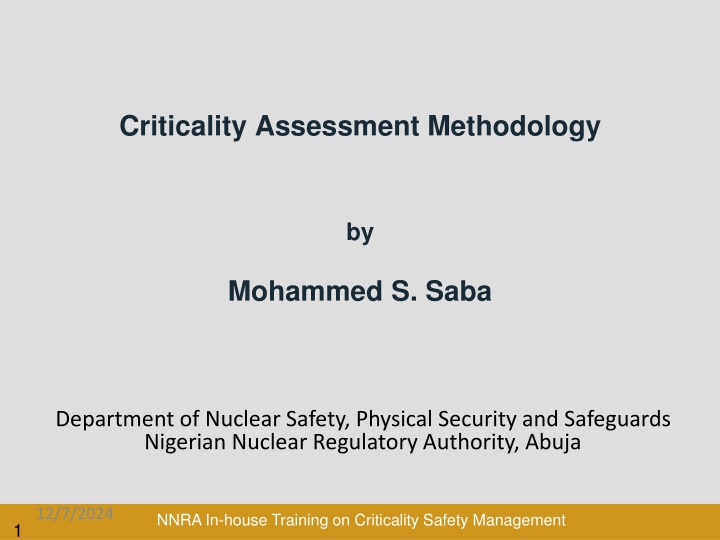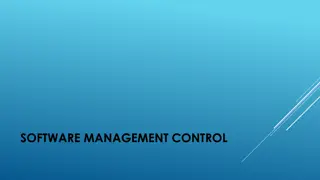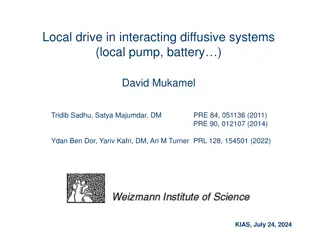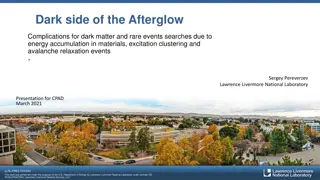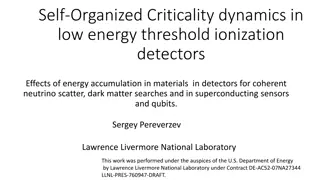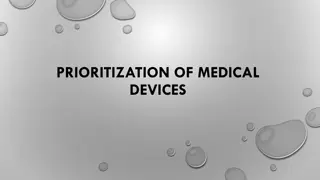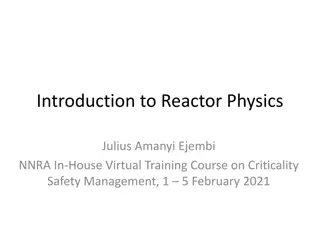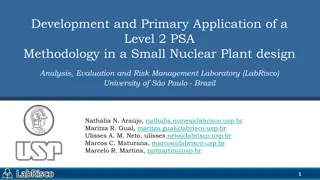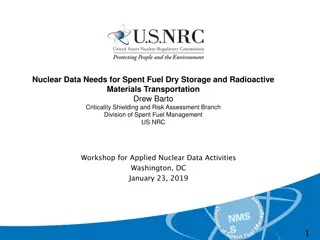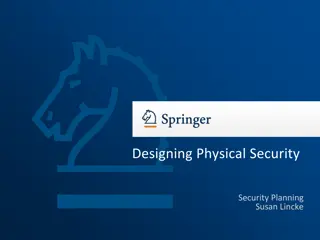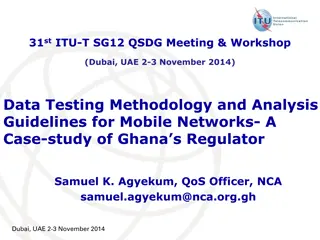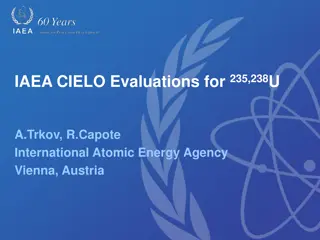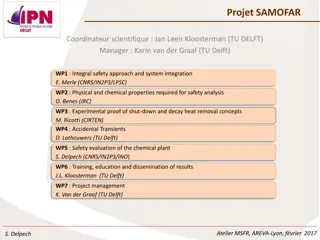Criticality Assessment Methodology
Criticality safety management in the nuclear industry, covering topics such as fault identification, safety measures, criticality safety assessment, and the evolution of criticality safety documentation. It emphasizes the importance of proper documentation and control requirements for nuclear criticality safety.
Download Presentation

Please find below an Image/Link to download the presentation.
The content on the website is provided AS IS for your information and personal use only. It may not be sold, licensed, or shared on other websites without obtaining consent from the author.If you encounter any issues during the download, it is possible that the publisher has removed the file from their server.
You are allowed to download the files provided on this website for personal or commercial use, subject to the condition that they are used lawfully. All files are the property of their respective owners.
The content on the website is provided AS IS for your information and personal use only. It may not be sold, licensed, or shared on other websites without obtaining consent from the author.
E N D
Presentation Transcript
Criticality Assessment Methodology by Mohammed S. Saba Click to add Text Department of Nuclear Safety, Physical Security and Safeguards Nigerian Nuclear Regulatory Authority, Abuja 12/7/2024 NNRA In-house Training on Criticality Safety Management 1
Objectives Describe the identification of safety measures Understand the fault identification process Define single or multiple parameter limits Explain why the safety case will evolve Define the scope of assessment Define the scope, and describe the key aspects required, of a criticality safety assessment 12/7/2024 NNRA In-house Training on Criticality Safety Management 2
Relationship to Nuclear Safety Criticality safety is one of a number of disciplines used to ensure the safety of nuclear facilities and processes A criticality safety assessment must recognise this Design Basis Analysis (DBA) can be used to reduce risks to ALARP levels 12/7/2024 NNRA In-house Training on Criticality Safety Management 3
Fault Identification Process Faults and fault sequences can be identified using: HAZID/HAZOP Design reviews Plant walk-downs Criticality hazard lists But the fault identification process is not perfect 12/7/2024 NNRA In-house Training on Criticality Safety Management 4
Criticality Safety Evolution Like other nuclear safety documentation, the criticality safety assessment will need to evolve through life: New (or modified) processes may be needed Near misses may be identified Additional faults may become apparent Modifications (i.e. to the building) may have implications for criticality Aging of materials may cause an increased criticality hazard 12/7/2024 NNRA In-house Training on Criticality Safety Management 5
Criticality Safety Assessment One of the more difficult tasks of a criticality safety specialist is proper documentation of the establishment of controlled parameters and basis for nuclear criticality safety limits derived for the controlled parameters In addition, clear specifications of associated control requirements and functionality to safely operate a process or facility that contains fissile material must be clearly communicated to operating personnel 12/7/2024 NNRA In-house Training on Criticality Safety Management 6
Criticality Safety Assessment Standards and regulation provide a framework that should be followed to ensure nuclear criticality safety 12/7/2024 NNRA In-house Training on Criticality Safety Management 7
Criticality Safety Assessment ANSI/ANS -8.19-(1996), Administrative Practices for Nuclear Criticality Safety, Section 8, states that, Before the start of a new operation with fissile material, or before an existing operation is changed, it shall be determined and documented that the entire process will be subcritical under both normal and credible abnormal conditions. 12/7/2024 NNRA In-house Training on Criticality Safety Management 8
Criticality Safety Assessment Nuclear criticality safety assessments shall be documented with sufficient detail, clarity, and lack of ambiguity to allow independent judgment of results. To facilitate this, a criticality safety specialist must be knowledgeable of operations that govern fissile processes and must have a firm grasp of the analytic tools and their limitations and standards and regulations 12/7/2024 NNRA In-house Training on Criticality Safety Management 9
Criticality Safety Assessment Criticality safety assessments should be independently reviewed by another qualified criticality safety specialist not directly involved in the preparation of the assessment 12/7/2024 NNRA In-house Training on Criticality Safety Management 10
Criticality Safety Assessment The following provides a summary of what constitutes an acceptable criticality safety assessment and the logic used its generation Facility-specific administrative requirements ultimately dictate the format and content of an criticality safety assessment; however, the following elements are needed to meet the minimum acceptable requirements 12/7/2024 NNRA In-house Training on Criticality Safety Management 11
Criticality Safety Assessment Identifies and addresses the credible concerns (e.g., event sequences, contingencies) of criticality safety importance for the defined system The criticality safety assessment is prepared or updated for each new or significantly modified unit or process system at the facility in accordance with established internal procedures by qualified criticality safety staff 12/7/2024 NNRA In-house Training on Criticality Safety Management 12
Criticality Safety Assessment Limits/controls established during the assessment should be acceptable to line management prior to their implementation This can be integral to the assessment itself or documented via procedure The scope and content of any given criticality safety assessment reflects the needs and characteristics of the system being analysed and may/will include the following applicable elements: 12/7/2024 NNRA In-house Training on Criticality Safety Management 13
Scope Defines the stated purpose of the evaluation and the maximum enrichment and isotopes of the fissile material being processed. 12/7/2024 NNRA In-house Training on Criticality Safety Management 14
Background Presents an overview of the process that is affected by the proposed change (or installation) and includes a process description, flow diagrams, normal operating conditions, system interfaces, and other aspects important to design considerations. 12/7/2024 NNRA In-house Training on Criticality Safety Management 15
Assumptions Identifies and describes the assumptions used in the assessment Worst credible conditions of materialcomposition Density Enrichment internal/external moderation Structures 12/7/2024 NNRA In-house Training on Criticality Safety Management 16
Controls Identifies and describes the controls (e.g., items relied on for safety) required for nuclear criticality safety of the facility or process Should also include a statement that summarises the interface considerations with other units or process areas and any other interdependences 12/7/2024 NNRA In-house Training on Criticality Safety Management 17
Models Identifies and describes the model used in the evaluation, including the identification and description of both normal and credible upset conditions The reasons for using, and the applicability of, the model used should be stated Naming conventions used in the model, key input listings and corresponding geometry plots for both normal and credible upset conditions should all be provided (possibly in an annex) 12/7/2024 NNRA In-house Training on Criticality Safety Management 18
Results The outcome of implementing the model Identifies and describes how the calculations were performed, what analytic methods or reference documents were used, and presents a tabular listing of the calculation results with associated uncertainty (e.g. keff 2 ) as a function of the key parameters (e.g. mass). 12/7/2024 NNRA In-house Training on Criticality Safety Management 19
Results Any assigned bias or approximations used in the calculation should be clearly stated, made traceable to a documented validation report, and incorporated into both normal and credible upset limit comparisons May also directly reference hand calculations and/or published handbook results. 12/7/2024 NNRA In-house Training on Criticality Safety Management 20
Upset Conditions Identifies and describes the concise summary of the upset conditions considered credible for the defined unit or process system Includes a discussion as to how the established limits are addressed for each credible process upset (e.g. accident sequence), and should clearly demonstrate how the double contingency principle is met. 12/7/2024 NNRA In-house Training on Criticality Safety Management 21
Safety Requirements Presents both the design specifications and the criticality safety requirements for correct operational implementation of the established controls These requirements are incorporated into operating procedures, training, maintenance, and quality assurance procedure requirements Input from both process engineering and operations management is required to implement the requirements. 12/7/2024 NNRA In-house Training on Criticality Safety Management 22
Compliance & Verification Statements regarding compliance with licence conditions should be provided Verification by independent qualified criticality safety professional, not directly involved in its preparation, could be included at this phase or later in the approval process This would include the signature of the individual, the date of peer review, and any comments or recommendations 12/7/2024 NNRA In-house Training on Criticality Safety Management 23
Annexes Here is placed information used in calculations or results (e.g. parametric sensitivity studies, references, key inputs, model geometry plots, equipment sketches, useful mixture nuclide identification/number densities, and related data) for each defined system. 12/7/2024 NNRA In-house Training on Criticality Safety Management 24
